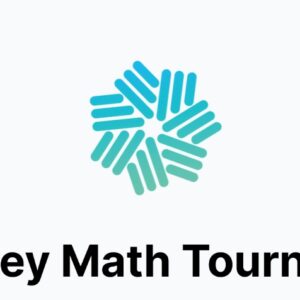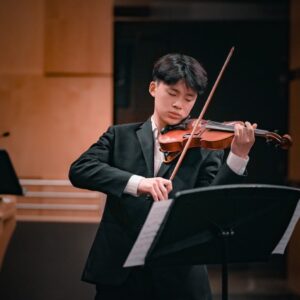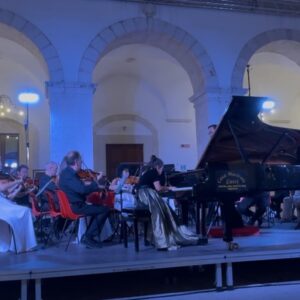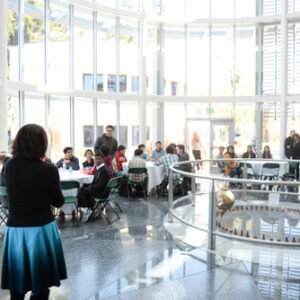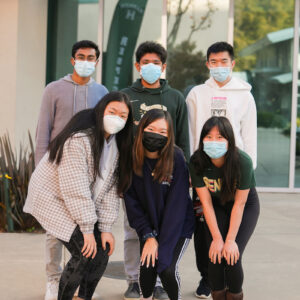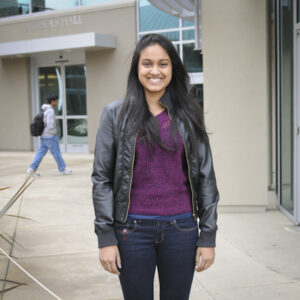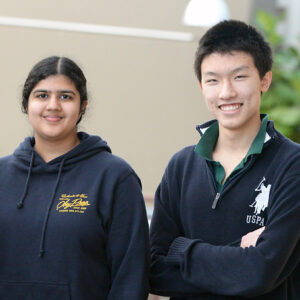This article originally appeared in the winter 2014 Harker Quarterly.
Every year, dozens of Harker’s upper school students submit projects to the Intel Science Talent Search and Siemens Competition. These projects, often created during summer internships at university science labs, are the result of months of research, writing and refinement. This feature highlights just a fraction of the amazing work being performed by Harker students every year. To read more about the projects on page 29, please go to our Science Projects 2014 section in Harker News, or search “perseverance.”
Roshni Pankhaniya
Grade 12
For her project, “Analyzing First-Trimester MicroRNA as a Marker for Assessing Adverse Pregnancy Risk,” senior Roshni Pankhaniya researched at Stanford University’s Human Immune Monitoring Center (HIMC). She was especially interested in immunology. “When looking for an area of research, I focused on finding professors targeting specific disorders/diseases,” she said. Her mentors, Xuhuai Ji and Holden T. Maecker, “helped me come up with the basic experimental design of the project and advised me on how to conduct the data analysis.”
Pankhaniya found her research internship by searching for projects that she found interesting and contacting the professors working on them. “I chose to work on this specific project because preeclampsia is a reproductive condition faced by approximately 8 percent of women worldwide, is the leading cause of maternal mortality and could not be detected prior to 10 weeks gestation, the latest time period for preventative therapy,” she said. Her goal was to come up with a way of detecting preeclampsia before 10 weeks gestation in order to find ways to treat it and thus lower the number of maternal deaths.
“It was great being able to work with experts in the field in such an advanced technical setting,” Pankhaniya said. “In addition to doing research, I was able to attend lectures given by Stanford and visiting professors, as well as talk to other professors in the department about their research.”
Despite being a high school student, Pankhaniya found the staff at HIMC to be welcoming and respectful. “It was amazing how eagerly they welcomed a high school student into the lab and never for a moment did I feel that I was ‘just’ a high school student, but rather was a member of the team,” she recalled.
Among her most exciting moments during her research was discovering with the team that “we could use maternal cell MicroRNA to detect risk for preeclampsia prior to 10 weeks gestation. Our findings are really interesting in that they suggest that maternal cell MicroRNA plays a greater role in fetal development than placental cell MicroRNA. We will look to understand why that is so in the future.
“Overall,” Panhkaniya said, “this was one of the most fulfilling and most memorable experiences of high school due to interactions I was able to have with experts in the field and the research experience I gained.”
David Lin
Grade 12
Senior David Lin turned to cosmology for his project, “Physical Properties and Evolution of Gravitationally Bound Halo Structures in Cosmological Dark Matter Simulations.”
“I chose this area of research since it was an interesting intersection of physics, computer science and astronomy,” Lin said. His project concerned the characteristics of dark matter halos, which play a key role in the formation of galaxies. “This knowledge will be useful in predicting how dark matter behaves in nonvirialized regions of space and will supplement existing galaxy formation theories.”
Lin was in good company during his time researching at the University of California, Santa Cruz, being mentored by Dr. Joel Primack and postdoctoral researcher Miguel Rocha. “One of the most exciting parts of my research was being able to work under such accomplished faculty,” he said. “For instance, [Primack] pioneered the famous LCDM Theory, which explains how the universe evolved after the Big Bang.”
Harker faculty, including upper school science teachers Chris Spenner and Anita Chetty, were instrumental in helping Lin find the right opportunity. “Many of the faculty like Mr. Spenner and Ms. Chetty helped me find my internship opportunity and helped edit my research paper afterward,” he said.
One of the most interesting parts of Lin’s research was how the team measured dark matter. “Most matter in the universe is composed of dark matter, which doesn’t interact with light and is therefore difficult to measure,” he said. “As such, we use computer simulations to model this matter to find how the universe evolves over time.”
Cindy Liu
Grade 12
Cindy Liu, grade 12, enjoyed the work she was doing in science classes, so a research internship seemed like a natural next step. “I’ve always liked doing labs and reading articles in science classes, and I thought research would be a good way to learn more about a particular topic in a different way, not just through textbooks and lectures,” she said.
For her project, “Characterizing Novel Binders as Tools for Understanding Chloride Transport Mechanisms,” she researched at Stanford University’s molecular and cellular physiology department as well as under the Stanford Institutes of Medicine Summer Research (SIMR) program.
Because she enjoyed learning about the workings of the human body and cellular function, the program was a good fit. “I’m also considering pursuing medicine or biomedical engineering in the future, so this project seemed like a good way to test my interest in these areas,” she said.
Her research involved two proteins that were potential inhibitors of CLC, “a chloride-proton antiporter that moves chloride and protons across membranes,” Liu said. “If they are shown to bind to and inhibit CLC, they can be further characterized in order to help gain greater understanding of CLC structure and function.”
Liu found the experience to be rewarding, with some neat surprises. “This was my first time doing actual wet lab research, so I loved being able to set up the experiments and collect the raw data myself instead of just analyzing someone else’s data,” she said. “Also, since my project was part of a larger program for high school students, I got to meet other students with similar interests and listen to various presentations from graduate students, doctors and researchers – even a Nobel Prize winner!”
The resources and support Liu found at Harker proved invaluable in helping her discover this opportunity. “Harker has provided so many resources, from general information on various research opportunities to internships students can apply for directly through Harker,” she said. “Harker research and science teachers are also very supportive of students’ research ideas and goals.”
Liu would like to continue her studies in this field, but said she is keeping an open mind. “I hope to do science research in college, especially in molecular and cellular physiology if I get the chance. But I’m also open to exploring and learning about other fields as well!”
Rahul Balakrishnan
Grade 12
Senior Rahul Balakrishnan’s interest in computer science led him to the Science Internship Program (SIP) at the University of California, Santa Cruz, where he studied astronomy with mentor Angie Wolfgang, a graduate student. “I choose the astronomy field since it focuses on a broader application of computer science. I wanted to see programming at work outside of an office setting,” said Balakrishnan.
After seeing several Harker students complete successful internships at UC Santa Cruz, Balakrishnan began his own internship there after being alerted to the opportunity by science chair Anita Chetty. He found himself working in the university’s multi-disciplinary building, which was aptly named. “The research in this building was truly multidisciplinary, with a slight emphasis toward astronomy,” he said. “Not only did every floor sport a different field of science, but also I worked in the same room as other interns from the same program who were exploring projects related to cancer cells and marine animals.”
The overall atmosphere in the building was one of collaboration, with students helping one another in various ways. “Although we couldn’t collaborate in the specifics of each other’s projects, we aided each other through more general forms, such as coding, formatting spreadsheets and making PowerPoint presentations,” Balakrishnan said.
Balakrishnan’s project, “Designing a Spectroscopy Based Software to Produce Spectra of Kepler’s Binary Host Stars,” involved finding a way to identify binary stars. “We hoped to create a new system to confirm that two stars were binary stars, or gravitationally bound in some way.”
Collecting the data was one of the more fascinating parts of Balakrishnan’s internship. “I went to Lick Observatory on Mt. Hamilton to see how my mentor collected the pictures that I would analyze,” he recalled. “The process involved using a giant laser that shot a light into the clouds to simulate a star.
“Our program can turn an image of a star from a spectrometer into a fully developed spectral graph,” he added. “Although the project was hundreds of lines of code long, the most complex data structure I used was a two-dimensional list.”
Although he doesn’t plan to continue studying astronomy, the overall experience did enhance his applicable knowledge of computer science. “I will almost certainly use my acquired programming knowledge in future coding projects and college
classes,” he said.
Neil Movva
Grade 12
In an effort to explore the processes by which the body heals itself, senior Neil Movva studied under Dr. Jill Helms at the Hagey Lab for Reconstructive Surgery at Stanford University. The eventual result was his research project, “Force Responsive Reconstruction: Characterizing the Morphogenesis of the Periodontal Ligament through Biomechanical and Histological Analysis.”
“I’ve always been fascinated by the body’s self-healing processes, and have done previous research on wound healing, tissue reconstruction and biomaterials,” Movva said. “Studying the reconstruction of ligaments is vital to furthering our understanding of how the human body adapts to changing physical conditions, and is especially relevant in the context of modern society’s growing senior population that will experience ligament wear and degeneration.”
In his research, Movva helped reignite a field that he believed had gone stagnant. “I employed advanced, novel techniques to identify and then demonstrate our new hypothesis regarding collagen fiber reconstruction at the cellular level,” he said, “bringing a new, data-backed viewpoint to the field after more than 50 years of stagnation.”
Helms “has been incredibly generous in sharing her knowledge and offering guidance as I learned the ropes of professional research,” he added.
He also found help among Harker’s science faculty, both in finding opportunities and refining his work. “Mr. Chris Spenner has fostered my interest in science research for the past three years, and graciously wrote recommendation letters to land me a position at Helms’ lab,” Movva said. “After I came back to school, Ms. Chetty patiently reviewed and edited my paper, while Mr. Spenner again lent his expertise to answer my questions as they popped up.”
One of the most exciting aspects of Movva’s work was the possibility of creating incredibly accurate computer models that can greatly assist doctors. “With the biologically corroborated framework I documented,” he said, “doctors may soon be able to perform rapid computer modeling of joints and other bony structures to determine the precisely optimal solution before beginning any invasive procedures.”
He also enjoyed seeing his work visualized through state-of-the- art technology. “A large part of my project focused on biomechanical computer-assisted modeling, and it’s hard to beat the excitement of seeing the first solution, visualized as a mesmerizing 3-D heatmap, after weeks of model construction and optimization,” he explained.
Karen Tu
Grade 11
Although she had been interested in biology for some time, junior Karen Tu decided to embark on an internship to “get a better idea of what biological/wet lab research was like.”
She ended up at the pathology department at Stanford University, where she and a partner were mentored by graduate student Andrew Huh. “He basically taught us everything from basic biology to dissection techniques for our project,” Tu said.
While admitting that she “didn’t really have a specific interest in genetics or neurodegenerative diseases before my internship,” Tu developed an interest in the topic while researching for her project, “A Novel Tool for Monitoring Mitochondrial Calcium Dynamics in Dopaminergic Neurons.”
“I think that neurological diseases are really interesting because even a small change in the concentration of a certain substance in your brain could have drastic effects,” she said. “It’s really hard for doctors to diagnose and treat these diseases, so this field of research is also really important for improving our understanding of these diseases.”
Tu’s project was to develop [research that] may be used to test treatments for Parkinson’s disease. “In our project, we needed to find a single white-eyed fly from our entire stock,” she said. “This fly indicated that our project had succeeded, so we were really excited when we finally found it.”
Her colleagues also made her feel welcome and included. “Our lab had monthly lab meetings, where everyone would come down from their various rooms and discuss their research and the problems they encountered together,” Tu said. “The PI (principal investigator) whom I worked with and visiting researchers from other universities gave lectures, which were a highlight of the summer.”
One of the more fascinating things she learned during the course of her research, she said, was the stunning variety of fruit flies. “Before I started this project, I had no idea that fruit flies could have so many different physical variations,” she said. “There’s an entire spectrum of eye colors, wing shapes and other random appendages that they can develop.”

